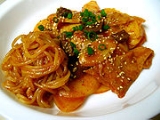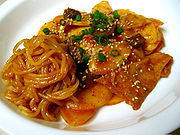
Tteokbokki
Encyclopedia
Tteokbokki, also known as Ddeokbokki is a popular Korean snack food which is commonly purchased from street vendors or Pojangmacha
. Originally it was called tteok
jjim
(떡찜), and was a braised dish of sliced rice cake
, meat, eggs, and seasoning. Tteok jjim an early variant of modern tteokbokki, was once a part of Korean royal court cuisine
. This type of tteokbokki was made by boiling tteok
, meat, vegetables, eggs, and seasonings in water, and then serving it topped with ginkgo nuts and walnut
s. In its original form, tteokbokki, which was then known as gungjung tteokbokki, was a dish served in the royal court and regarded as a representative example of haute cuisine. The original tteokbokki was a stir-fried
dish consisting of garaetteok (가래떡, cylinder-shaped tteok) combined with a variety of ingredients, such as beef, mung bean sprouts, green onions, shiitake
mushrooms, carrots, and onions, and seasoned with soy sauce.
 Following the Korean War
Following the Korean War
a new type of tteokbokki became very popular. While the older version was a savory dish, this latter type was much more spicy, and quickly became more popular than the older traditional dish. In addition to traditional ingredients, this tteokbokki used gochujang
, a hot paste made from chilli peppers, along with fish cakes. Other ingredients added to tteokbokki include boiled eggs, pan-fried mandu
(Korean dumplings), sausages, ramyeon
(which then becomes rabokki/labokki 라볶이), and cheese. These days, many kinds of tteokbokki are popular such as seafood tteokbokki(해물 떡볶이) or rice tteokbokki(쌀떡볶이). Flour tteokbokki was popular in early days, but rice tteokbokki is more popular these days.
Sindang-dong
in Seoul
, where tteokbokki was first sold, is still very famous for the dish, which has become one of Korea's most popular snack foods.
Since Tteokbokki is one of the most famous snacks, one will easily find a place to enjoy eating Tteokbokki in Korea.
Pojangmacha
Pojangmacha refers to small tented restaurants on wheels, or street stalls in South Korea which sell a variety of popular street foods such as hotteok, gimbap, tteokbokki, sundae, odeng, and anju . It literally means "covered wagon" in Korean...
. Originally it was called tteok
Tteok
Tteok is a class of Korean rice cakes made with glutinous rice flour , by steaming. Normal rice flour can be used for some kinds of tteok. There are hundreds of different kinds of tteok eaten year round...
jjim
Jjim
Jjim is a Korean cuisine term referring to dishes made by steaming or boiling meat, chicken, fish, or shellfish which have been marinated in a sauce or soup. The cooking technique originally referred to dishes cooked in a siru by steaming...
(떡찜), and was a braised dish of sliced rice cake
Rice cake
A rice cake may be any kind of food item made from rice that has been shaped, condensed, or otherwise combined into a single object. A wide variety of rice cakes exist in many different cultures in which rice is eaten, and are particularly prevalent in Asia. The origin of rice cake seems to be...
, meat, eggs, and seasoning. Tteok jjim an early variant of modern tteokbokki, was once a part of Korean royal court cuisine
Korean royal court cuisine
Korean royal court cuisine was the style of cookery within Korean cuisine traditionally consumed at the court of the Joseon Dynasty, which ruled Korea from 1392 to 1910. There has been a revival of this cookery style in the 21st century...
. This type of tteokbokki was made by boiling tteok
Tteok
Tteok is a class of Korean rice cakes made with glutinous rice flour , by steaming. Normal rice flour can be used for some kinds of tteok. There are hundreds of different kinds of tteok eaten year round...
, meat, vegetables, eggs, and seasonings in water, and then serving it topped with ginkgo nuts and walnut
Walnut
Juglans is a plant genus of the family Juglandaceae, the seeds of which are known as walnuts. They are deciduous trees, 10–40 meters tall , with pinnate leaves 200–900 millimetres long , with 5–25 leaflets; the shoots have chambered pith, a character shared with the wingnuts , but not the hickories...
s. In its original form, tteokbokki, which was then known as gungjung tteokbokki, was a dish served in the royal court and regarded as a representative example of haute cuisine. The original tteokbokki was a stir-fried
Stir frying
Stir frying is an umbrella term used to describe two Chinese cooking techniques for preparing food in a wok: chǎo and bào . The term stir-fry was introduced into the English language by Buwei Yang Chao, in her book How to Cook and Eat in Chinese, to describe the chǎo technique...
dish consisting of garaetteok (가래떡, cylinder-shaped tteok) combined with a variety of ingredients, such as beef, mung bean sprouts, green onions, shiitake
Shiitake
The Shiitake is an edible mushroom native to East Asia, which is cultivated and consumed in many Asian countries, as well as being dried and exported to many countries around the world. It is a feature of many Asian cuisines including Vietnamese, Chinese, Japanese, Korean and Thai...
mushrooms, carrots, and onions, and seasoned with soy sauce.
Modern history

Korean War
The Korean War was a conventional war between South Korea, supported by the United Nations, and North Korea, supported by the People's Republic of China , with military material aid from the Soviet Union...
a new type of tteokbokki became very popular. While the older version was a savory dish, this latter type was much more spicy, and quickly became more popular than the older traditional dish. In addition to traditional ingredients, this tteokbokki used gochujang
Gochujang
Gochujang is a savory and pungent fermented Korean condiment. Traditionally, it has been naturally fermented over years in large earthen pots outdoors, more often on an elevated stone platform, called jangdokdae in the backyard...
, a hot paste made from chilli peppers, along with fish cakes. Other ingredients added to tteokbokki include boiled eggs, pan-fried mandu
Mandu (dumpling)
Mandu are dumplings in Korean cuisine. They are similar to pelmeni and pierogi in some Slavic cultures. The name is a cognate to the names of similar types of meat-filled dumplings in Central Asia, such as Turkish manti, Kazakh manty, and Uzbek manti.In Korean cuisine, mandu generally denotes a...
(Korean dumplings), sausages, ramyeon
Ramen
is a Japanese noodle dish. It consists of Chinese-style wheat noodles served in a meat- or fish-based broth, often flavored with soy sauce or miso, and uses toppings such as , , kamaboko, green onions, and occasionally corn...
(which then becomes rabokki/labokki 라볶이), and cheese. These days, many kinds of tteokbokki are popular such as seafood tteokbokki(해물 떡볶이) or rice tteokbokki(쌀떡볶이). Flour tteokbokki was popular in early days, but rice tteokbokki is more popular these days.
Sindang-dong
Sindang-dong
Sindang-dong is a dong, neighbourhood of Jung-gu in Seoul, South Korea.-External links:*...
in Seoul
Seoul
Seoul , officially the Seoul Special City, is the capital and largest metropolis of South Korea. A megacity with a population of over 10 million, it is the largest city proper in the OECD developed world...
, where tteokbokki was first sold, is still very famous for the dish, which has become one of Korea's most popular snack foods.
Since Tteokbokki is one of the most famous snacks, one will easily find a place to enjoy eating Tteokbokki in Korea.
See also
- GochujangGochujangGochujang is a savory and pungent fermented Korean condiment. Traditionally, it has been naturally fermented over years in large earthen pots outdoors, more often on an elevated stone platform, called jangdokdae in the backyard...
- DoenjangDoenjangDoenjang is a traditional Korean fermented soybean paste. Its name literally means "thick paste" in Korean.-Production:...
- Korean cuisine
- Niangao (similar food in Chinese cuisine)
- Ramyeon
External links
Tteokbokki recipe History of Tteokbokki- Recipe for Spicy Tteokbokki at Messy Witchen

